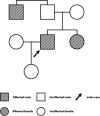A case of congenital prothrombin deficiency with two concurrent mutations in the prothrombin gene
- PMID: 33977210
- PMCID: PMC8105154
- DOI: 10.1002/rth2.12510
A case of congenital prothrombin deficiency with two concurrent mutations in the prothrombin gene
Abstract
Congenital prothrombin deficiency is an extremely rare, autosomal recessive bleeding disorder with a prevalence of 1 in 2 million individuals. Here, we report a case of congenital prothrombin deficiency with two concurrent mutations in the prothrombin gene (F2), affecting the heavy B chain. The patient presented with a history of multiple bleeding events in his youth that are mostly trauma associated, with a family history of prothrombin deficiency. Laboratory analysis showed a prolonged activated partial thromboplastin time and a prothrombin activity level of 5%. Genetic analysis of the F2 gene identified two heterozygous variants; one is a previously reported pathogenic deletion (c.1814_1815del; p.His605Argfs*13), and the other is a novel missense variant (c.1147C>T; p.Arg383Trp). In silico analysis predicted that p.Arg383Trp is likely to be disease causing, as it affects one of the anion-binding exosites-I of the B chain. This case highlights the significance of molecular findings in confirming the diagnosis of patients with congenital prothrombin deficiency.
Keywords: bleeding disorder; dysprothrombinemia; hypoprothrombinemia; prothrombin deficiency; prothrombin mutation.
© 2021 The Authors. Research and Practice in Thrombosis and Haemostasis published by Wiley Periodicals LLC on behalf of International Society on Thrombosis and Haemostasis (ISTH).
Figures


References
-
- Lancellotti S, Basso M, De Cristofaro R. Congenital prothrombin deficiency: an update. Semin Thromb Hemost. 2013;39(6):596–606. - PubMed
-
- Girolami A, Ferrari S, Cosi E, Girolami B, Lombardi AM. Congenital prothrombin defects: they are not only associated with bleeding but also with thrombosis: a new classification is needed. Hematology. 2018;23(2):105–110. - PubMed
-
- Peyvandi F, di Michele D, Bolton‐maggs PHB, Lee CA, Tripodi A, Srivastava A. Classification of rare bleeding disorders (RBDs) based on the association between coagulant factor activity and clinical bleeding severity. J Thromb Haemost. 2012;10(9):1938–1943. - PubMed
-
- Bafunno V, Bury L, Tiscia GL, et al. A novel congenital dysprothrombinemia leading to defective prothrombin maturation. Thromb Res. 2014;134(5):1135–1141. - PubMed
-
- Pasmant E, Dumont B, Lacapere JJ, Dautzenberg MD, Bezeaud A. A severe neonatal presentation of factor II deficiency. Eur J Haematol. 2011;87(5):464–466. - PubMed
Publication types
LinkOut - more resources
Full Text Sources
Other Literature Sources
Miscellaneous

